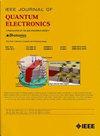Theoretical Simulation of Extended Mid-Wave Infrared High Operating Temperature InSb pBn Photodetectors
IF 2.2
3区 工程技术
Q3 ENGINEERING, ELECTRICAL & ELECTRONIC
引用次数: 0
Abstract
The application of the barrier architecture exhibits the potential in reducing the noise current and improving the performance of photodetectors. However, the development of mid-infrared InSb barrier detector is lagging far behind its III-V counterparts due to the problem of lattice mismatch. In this paper, we proposed two InSb barrier detectors that have reduced dark current and raised operating temperatures with the help of commercial software APSYS platform. The incorporation of a In0.72 Al0.28Sb barrier architecture to the InSb absorber offers a significant dark current reduction over the conventional InSb photodiode, regardless the presence of strain-induced defects within the barrier layers. At 150 K, the InSb bulk barrier detector has a cutoff wavelength at扩展中波红外高工作温度InSb - pBn光电探测器的理论模拟
势垒结构的应用在降低噪声电流和提高光电探测器的性能方面显示出潜力。然而,由于晶格失配问题,中红外InSb势垒探测器的发展远远落后于III-V类探测器。在本文中,我们提出了两种InSb势垒探测器,它们在商业软件APSYS平台的帮助下降低了暗电流并提高了工作温度。与传统InSb光电二极管相比,将In0.72 Al0.28Sb势垒结构结合到InSb吸收器中,无论势垒层内是否存在应变诱导缺陷,都能显著降低暗电流。在150 K时,InSb体势垒探测器的截止波长为$5.65 \mu \text{m}$。采用势垒设计,在- 220 mV时的暗电流为$9.96\乘以10^{-3}\text{a}$ /cm2,比InSb光电二极管低约77倍,在a - 220 mV偏置电压下,比探测率约为$2.07\乘以10^{11}$ cm Hz $^{1/2}$ /W,性能提高了约一个数量级。
本文章由计算机程序翻译,如有差异,请以英文原文为准。
求助全文
约1分钟内获得全文
求助全文
来源期刊

IEEE Journal of Quantum Electronics
工程技术-工程:电子与电气
CiteScore
4.70
自引率
4.00%
发文量
99
审稿时长
3.0 months
期刊介绍:
The IEEE Journal of Quantum Electronics is dedicated to the publication of manuscripts reporting novel experimental or theoretical results in the broad field of the science and technology of quantum electronics. The Journal comprises original contributions, both regular papers and letters, describing significant advances in the understanding of quantum electronics phenomena or the demonstration of new devices, systems, or applications. Manuscripts reporting new developments in systems and applications must emphasize quantum electronics principles or devices. The scope of JQE encompasses the generation, propagation, detection, and application of coherent electromagnetic radiation having wavelengths below one millimeter (i.e., in the submillimeter, infrared, visible, ultraviolet, etc., regions). Whether the focus of a manuscript is a quantum-electronic device or phenomenon, the critical factor in the editorial review of a manuscript is the potential impact of the results presented on continuing research in the field or on advancing the technological base of quantum electronics.
 求助内容:
求助内容: 应助结果提醒方式:
应助结果提醒方式:


